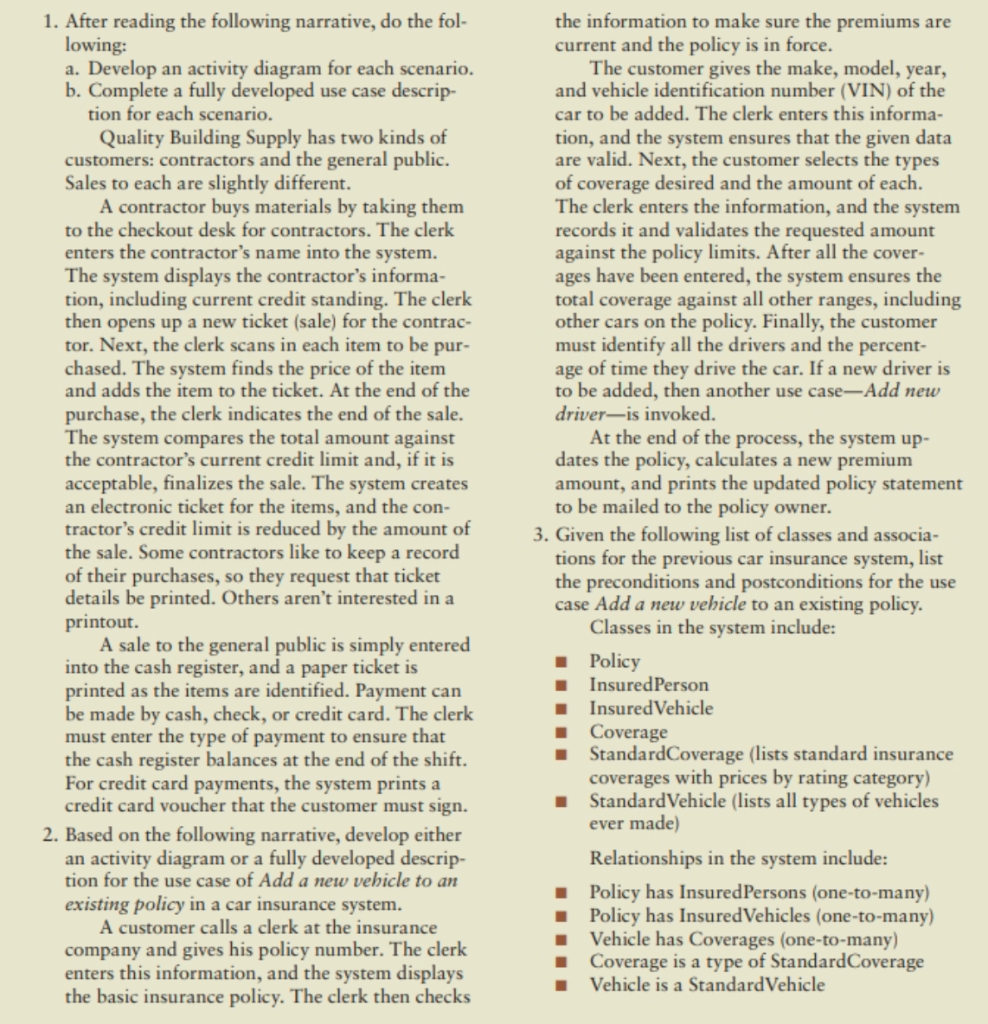Answered step by step
Verified Expert Solution
Question
1 Approved Answer
Develop an activity diagram. Develop an SSD. 1. After reading the following narrative, do the fol- lowing: a. Develop an activity diagram for each scenario.
- Develop an activity diagram.
- Develop an SSD.

1. After reading the following narrative, do the fol- lowing: a. Develop an activity diagram for each scenario. b. Complete a fully developed use case descrip- tion for each scenario. Quality Building Supply has two kinds of customers: contractors and the general public. Sales to each are slightly different. A contractor buys materials by taking them to the checkout desk for contractors. The clerk enters the contractor's name into the system. The system displays the contractor's informa- tion, including current credit standing. The clerk then opens up a new ticket (sale) for the contrac- tor. Next, the clerk scans in each item to be pur- chased. The system finds the price of the item and adds the item to the ticket. At the end of the purchase, the clerk indicates the end of the sale. The system compares the total amount against the contractor's current credit limit and, if it is acceptable, finalizes the sale. The system creates an electronic ticket for the items, and the con- tractor's credit limit is reduced by the amount of the sale. Some contractors like to keep a record of their purchases, so they request that ticket details be printed. Others aren't interested in a printout. A sale to the general public is simply entered into the cash register, and a paper ticket is printed as the items are identified. Payment can be made by cash, check, or credit card. The clerk must enter the type of payment to ensure that the cash register balances at the end of the shift. For credit card payments, the system prints a credit card voucher that the customer must sign. 2. Based on the following narrative, develop either an activity diagram or a fully developed descrip- tion for the use case of Add a new vehicle to an existing policy in a car insurance system. A customer calls a clerk at the insurance company and gives his policy number. The clerk enters this information, and the system displays the basic insurance policy. The clerk then checks the information to make sure the premiums are current and the policy is in force. The customer gives the make, model, year, and vehicle identification number (VIN) of the car to be added. The clerk enters this informa- tion, and the system ensures that the given data are valid. Next, the customer selects the types of coverage desired and the amount of each. The clerk enters the information, and the system records it and validates the requested amount against the policy limits. After all the cover- ages have been entered, the system ensures the total coverage against all other ranges, including other cars on the policy. Finally, the customer must identify all the drivers and the percent- age of time they drive the car. If a new driver is to be added, then another use case-Add new driver-is invoked. At the end of the process, the system up- dates the policy, calculates a new premium amount, and prints the updated policy statement to be mailed to the policy owner. 3. Given the following list of classes and associa- tions for the previous car insurance system, list the preconditions and postconditions for the use case Add a new vehicle to an existing policy. Classes in the system include: Policy Insured Person Insured Vehicle Coverage StandardCoverage (lists standard insurance coverages with prices by rating category) Standard Vehicle (lists all types of vehicles ever made) Relationships in the system include: Policy has Insured Persons (one-to-many) Policy has Insured Vehicles (one-to-many) Vehicle has Coverages (one-to-many) Coverage is a type of Standard Coverage Vehicle is a Standard Vehicle 1 1. After reading the following narrative, do the fol- lowing: a. Develop an activity diagram for each scenario. b. Complete a fully developed use case descrip- tion for each scenario. Quality Building Supply has two kinds of customers: contractors and the general public. Sales to each are slightly different. A contractor buys materials by taking them to the checkout desk for contractors. The clerk enters the contractor's name into the system. The system displays the contractor's informa- tion, including current credit standing. The clerk then opens up a new ticket (sale) for the contrac- tor. Next, the clerk scans in each item to be pur- chased. The system finds the price of the item and adds the item to the ticket. At the end of the purchase, the clerk indicates the end of the sale. The system compares the total amount against the contractor's current credit limit and, if it is acceptable, finalizes the sale. The system creates an electronic ticket for the items, and the con- tractor's credit limit is reduced by the amount of the sale. Some contractors like to keep a record of their purchases, so they request that ticket details be printed. Others aren't interested in a printout. A sale to the general public is simply entered into the cash register, and a paper ticket is printed as the items are identified. Payment can be made by cash, check, or credit card. The clerk must enter the type of payment to ensure that the cash register balances at the end of the shift. For credit card payments, the system prints a credit card voucher that the customer must sign. 2. Based on the following narrative, develop either an activity diagram or a fully developed descrip- tion for the use case of Add a new vehicle to an existing policy in a car insurance system. A customer calls a clerk at the insurance company and gives his policy number. The clerk enters this information, and the system displays the basic insurance policy. The clerk then checks the information to make sure the premiums are current and the policy is in force. The customer gives the make, model, year, and vehicle identification number (VIN) of the car to be added. The clerk enters this informa- tion, and the system ensures that the given data are valid. Next, the customer selects the types of coverage desired and the amount of each. The clerk enters the information, and the system records it and validates the requested amount against the policy limits. After all the cover- ages have been entered, the system ensures the total coverage against all other ranges, including other cars on the policy. Finally, the customer must identify all the drivers and the percent- age of time they drive the car. If a new driver is to be added, then another use case-Add new driver-is invoked. At the end of the process, the system up- dates the policy, calculates a new premium amount, and prints the updated policy statement to be mailed to the policy owner. 3. Given the following list of classes and associa- tions for the previous car insurance system, list the preconditions and postconditions for the use case Add a new vehicle to an existing policy. Classes in the system include: Policy Insured Person Insured Vehicle Coverage StandardCoverage (lists standard insurance coverages with prices by rating category) Standard Vehicle (lists all types of vehicles ever made) Relationships in the system include: Policy has Insured Persons (one-to-many) Policy has Insured Vehicles (one-to-many) Vehicle has Coverages (one-to-many) Coverage is a type of Standard Coverage Vehicle is a Standard Vehicle 1
Step by Step Solution
There are 3 Steps involved in it
Step: 1

Get Instant Access to Expert-Tailored Solutions
See step-by-step solutions with expert insights and AI powered tools for academic success
Step: 2

Step: 3

Ace Your Homework with AI
Get the answers you need in no time with our AI-driven, step-by-step assistance
Get Started


